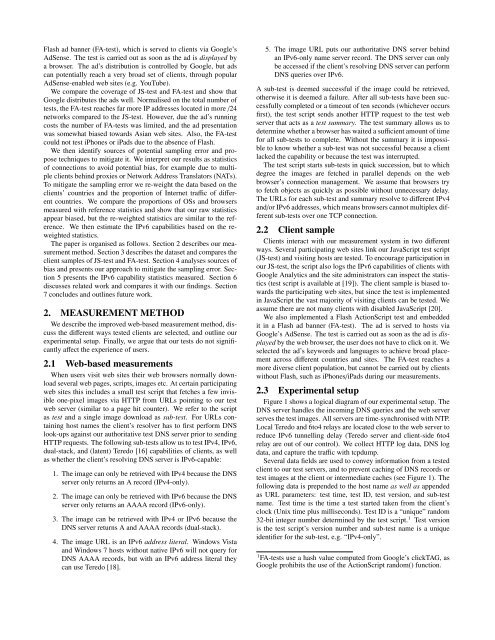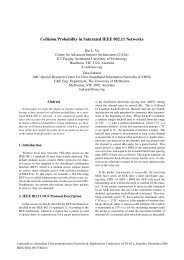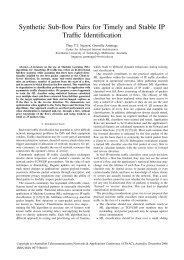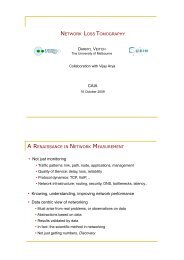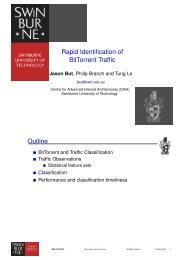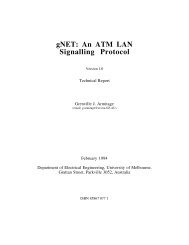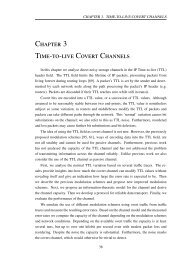Mitigating Sampling Error when Measuring Internet Client IPv6 ...
Mitigating Sampling Error when Measuring Internet Client IPv6 ...
Mitigating Sampling Error when Measuring Internet Client IPv6 ...
You also want an ePaper? Increase the reach of your titles
YUMPU automatically turns print PDFs into web optimized ePapers that Google loves.
Flash ad banner (FA-test), which is served to clients via Google’s<br />
AdSense. The test is carried out as soon as the ad is displayed by<br />
a browser. The ad’s distribution is controlled by Google, but ads<br />
can potentially reach a very broad set of clients, through popular<br />
AdSense-enabled web sites (e.g. YouTube).<br />
We compare the coverage of JS-test and FA-test and show that<br />
Google distributes the ads well. Normalised on the total number of<br />
tests, the FA-test reaches far more IP addresses located in more /24<br />
networks compared to the JS-test. However, due the ad’s running<br />
costs the number of FA-tests was limited, and the ad presentation<br />
was somewhat biased towards Asian web sites. Also, the FA-test<br />
could not test iPhones or iPads due to the absence of Flash.<br />
We then identify sources of potential sampling error and propose<br />
techniques to mitigate it. We interpret our results as statistics<br />
of connections to avoid potential bias, for example due to multiple<br />
clients behind proxies or Network Address Translators (NATs).<br />
To mitigate the sampling error we re-weight the data based on the<br />
clients’ countries and the proportion of <strong>Internet</strong> traffic of different<br />
countries. We compare the proportions of OSs and browsers<br />
measured with reference statistics and show that our raw statistics<br />
appear biased, but the re-weighted statistics are similar to the reference.<br />
We then estimate the <strong>IPv6</strong> capabilities based on the reweighted<br />
statistics.<br />
The paper is organised as follows. Section 2 describes our measurement<br />
method. Section 3 describes the dataset and compares the<br />
client samples of JS-test and FA-test. Section 4 analyses sources of<br />
bias and presents our approach to mitigate the sampling error. Section<br />
5 presents the <strong>IPv6</strong> capability statistics measured. Section 6<br />
discusses related work and compares it with our findings. Section<br />
7 concludes and outlines future work.<br />
2. MEASUREMENT METHOD<br />
We describe the improved web-based measurement method, discuss<br />
the different ways tested clients are selected, and outline our<br />
experimental setup. Finally, we argue that our tests do not significantly<br />
affect the experience of users.<br />
2.1 Web-based measurements<br />
When users visit web sites their web browsers normally download<br />
several web pages, scripts, images etc. At certain participating<br />
web sites this includes a small test script that fetches a few invisible<br />
one-pixel images via HTTP from URLs pointing to our test<br />
web server (similar to a page hit counter). We refer to the script<br />
as test and a single image download as sub-test. For URLs containing<br />
host names the client’s resolver has to first perform DNS<br />
look-ups against our authoritative test DNS server prior to sending<br />
HTTP requests. The following sub-tests allow us to test IPv4, <strong>IPv6</strong>,<br />
dual-stack, and (latent) Teredo [16] capabilities of clients, as well<br />
as whether the client’s resolving DNS server is <strong>IPv6</strong>-capable:<br />
1. The image can only be retrieved with IPv4 because the DNS<br />
server only returns an A record (IPv4-only).<br />
2. The image can only be retrieved with <strong>IPv6</strong> because the DNS<br />
server only returns an AAAA record (<strong>IPv6</strong>-only).<br />
3. The image can be retrieved with IPv4 or <strong>IPv6</strong> because the<br />
DNS server returns A and AAAA records (dual-stack).<br />
4. The image URL is an <strong>IPv6</strong> address literal. Windows Vista<br />
and Windows 7 hosts without native <strong>IPv6</strong> will not query for<br />
DNS AAAA records, but with an <strong>IPv6</strong> address literal they<br />
can use Teredo [18].<br />
5. The image URL puts our authoritative DNS server behind<br />
an <strong>IPv6</strong>-only name server record. The DNS server can only<br />
be accessed if the client’s resolving DNS server can perform<br />
DNS queries over <strong>IPv6</strong>.<br />
A sub-test is deemed successful if the image could be retrieved,<br />
otherwise it is deemed a failure. After all sub-tests have been successfully<br />
completed or a timeout of ten seconds (whichever occurs<br />
first), the test script sends another HTTP request to the test web<br />
server that acts as a test summary. The test summary allows us to<br />
determine whether a browser has waited a sufficient amount of time<br />
for all sub-tests to complete. Without the summary it is impossible<br />
to know whether a sub-test was not successful because a client<br />
lacked the capability or because the test was interrupted.<br />
The test script starts sub-tests in quick succession, but to which<br />
degree the images are fetched in parallel depends on the web<br />
browser’s connection management. We assume that browsers try<br />
to fetch objects as quickly as possible without unnecessary delay.<br />
The URLs for each sub-test and summary resolve to different IPv4<br />
and/or <strong>IPv6</strong> addresses, which means browsers cannot multiplex different<br />
sub-tests over one TCP connection.<br />
2.2 <strong>Client</strong> sample<br />
<strong>Client</strong>s interact with our measurement system in two different<br />
ways. Several participating web sites link our JavaScript test script<br />
(JS-test) and visiting hosts are tested. To encourage participation in<br />
our JS-test, the script also logs the <strong>IPv6</strong> capabilities of clients with<br />
Google Analytics and the site administrators can inspect the statistics<br />
(test script is available at [19]). The client sample is biased towards<br />
the participating web sites, but since the test is implemented<br />
in JavaScript the vast majority of visiting clients can be tested. We<br />
assume there are not many clients with disabled JavaScript [20].<br />
We also implemented a Flash ActionScript test and embedded<br />
it in a Flash ad banner (FA-test). The ad is served to hosts via<br />
Google’s AdSense. The test is carried out as soon as the ad is displayed<br />
by the web browser, the user does not have to click on it. We<br />
selected the ad’s keywords and languages to achieve broad placement<br />
across different countries and sites. The FA-test reaches a<br />
more diverse client population, but cannot be carried out by clients<br />
without Flash, such as iPhones/iPads during our measurements.<br />
2.3 Experimental setup<br />
Figure 1 shows a logical diagram of our experimental setup. The<br />
DNS server handles the incoming DNS queries and the web server<br />
serves the test images. All servers are time-synchronised with NTP.<br />
Local Teredo and 6to4 relays are located close to the web server to<br />
reduce <strong>IPv6</strong> tunnelling delay (Teredo server and client-side 6to4<br />
relay are out of our control). We collect HTTP log data, DNS log<br />
data, and capture the traffic with tcpdump.<br />
Several data fields are used to convey information from a tested<br />
client to our test servers, and to prevent caching of DNS records or<br />
test images at the client or intermediate caches (see Figure 1). The<br />
following data is prepended to the host name as well as appended<br />
as URL parameters: test time, test ID, test version, and sub-test<br />
name. Test time is the time a test started taken from the client’s<br />
clock (Unix time plus milliseconds). Test ID is a “unique” random<br />
32-bit integer number determined by the test script. 1 Test version<br />
is the test script’s version number and sub-test name is a unique<br />
identifier for the sub-test, e.g. “IPv4-only”.<br />
1 FA-tests use a hash value computed from Google’s clickTAG, as<br />
Google prohibits the use of the ActionScript random() function.


